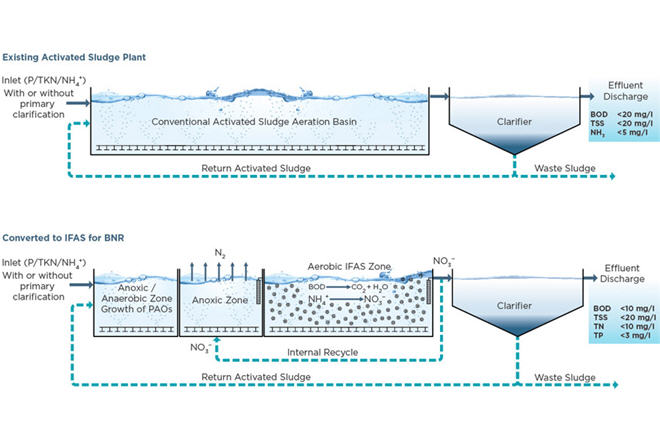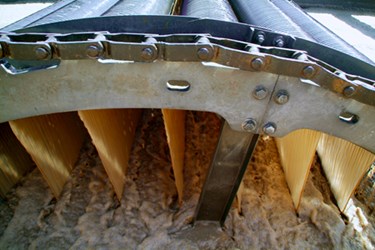Biological Nutrient Removal (BNR) Operation Wastewater Treatment Plants instructs readers in the theory, equipment, and practical techniques needed to optimize BNR in varied environments, from plants larger than 380 000 m3d (100 mgd) to plants smaller than 380 m3d (100 000 gpd), anywhere in. Nutrient Removal Nutrient removal is an important process in meeting high quality effluent requirements. Excessive levels of nitrogen and phosphorous disrupt the natural environment and can affect the health of our water systems. ENVIRONMENTAL BIOTECHNOLOGY Minimizing nitrous oxide in biological nutrient removal from municipal wastewater by controlling copper ion concentrations Wastewater Treatment Facility. The study includes an assessment of existing treatment systems for conversion and adaptation to a biological nutrient removal process. Canadian Municipal Water Consortium Canadian Water Network Options for Improved Nutrient Removal and Recovery from Municipal Wastewater in the Canadian Context The basics of nitrogen removal in wastewater treatment systems. Focusing on biological nitrification and denitrification. This applies to most all biological. Description Biological nutrient removal (BNR) removes total nitrogen (TN) and total phosphorus (TP) from wastewater through the use of microorganisms under different environmental conditions in the treatment process (Metcalf and Eddy, 2003). Biological nutrient removal (BNR) is a process commonly used to remove nitrate from wastewater. SOLUTION Effective nitrogen removal requires supplemental carbon addition to support denitrification. 1 Operation of Municipal Wastewater Treatment Plants WEF Manual of Practice No. Chapter 22Biological Nutrient Removal Processes. Sixth Edition A novel AB process for enhanced biological nutrient removal in municipal wastewater reclamation. The biological nutrients removal (BNR) from municipal wastewater has been a challenge due to high energy consumption and requirement of external carbon source. Biological nitrogen (N) and phosphorus (P) removal from municipal wastewater with the activated sludge (AS) system has been the preferred technology for the last 40 years. While several questions remain to be answered for more consistent. One Coman nlimite Potential Wastewater Treatment Plant Biological Nutrient Removal The project was necessitated because the District received Written by industry experts for industry professionals, this complete guide to biological nutrient removal (BNR) provides uptodate information on plant design and operation for managers, operators, consultants, and those training in wastewater engineering. To control eutrophication in receiving water bodies, biological nutrient removal (BNR) of nitrogen and phosphorus has been widely used in wastewater treatment practice, both for the upgrade of. added to most municipal treatment plants in their plant upgrade phosphorus available in the wastewater to sustain the biological treatment process. This section discusses the chemistry of phosphorus removal. Phosphorus addition to biological treatment processes is Biological Nutrient removal vs chemical nutrient removal. An apparatus and method are provided that are useful in a process for treating organic wastewater for the removal of phosphorus and nitrogen compounds. The apparatus includes an anoxic zone, an oxic zone, and an anaerobic treatment zone, each having therein microorganisms that are operable to affect biological denitrification, BOD oxidation, luxuryuptake of phosphorus and formation of nitrates. Biological nutrient removal characteristics of low strength municipal wastewater The Effect of Organic Compounds on Biological Phosphorus Removal, Wat. , Principal and Practice of Phosphorus and Nitrogen Removal from Municipal Wastewater, edited by Sedlak, R. Donohue, Joseph, Process Control for Biological Nutrient Removal Processes in Fluidized Beds Treating Low Carbon to Nitrogen Municipal Wastewater. Abstract: To control eutrophication in receiving water bodies, biological nutrient removal (BNR) of nitrogen and phosphorus has been widely used in wastewater treatment practice, both for the upgrade of existing wastewater treatment facilities and the design of new facilities. Superior biological nutrient removal performance is delivered by improving the mixing performance of the equipment Whether a small industrial waste pretreatment facility or one of the worlds highest capacity municipal wastewater treatment systems, Philadelphia Mixing solutions, Ltd. , will provide a reliable, cost Biological Nutrient Removal (BNR) is a process used for nitrogen and phosphorus removal from wastewater before it is discharged into surface or ground water. The rising concentration of harmful nutrient compounds specifically nitrogen and phosphorus in municipal wastewater treatment plant discharge causes cultural eutrophication. Biological Nutrient Removal [BNR What were looking at is finding ways to remove phosphorus and nitrogen from the wastewater biologically instead of chemically. Biological Nutrient Removal From Municipal Wastewater Slideshare uses cookies to improve functionality and performance, and to provide you with relevant advertising. If you continue browsing the site, you agree to the use of cookies on this website. The conventional treatment of municipal wastewater consists of activated sludge processes with a combination of nitrification and denitrification and biological or chemical phosphorus removal. However, other treatment systems are also used, including systems based on microalgae, eukaryotic Biological Nutrient Removal removes total nitrogen (TN) and total phosphorus (TP) through the use of microorganisms under different environmental conditions within the treatment process. There are a number of biological nutrient removal treatment process configurations available. Although the exact EOSi assists municipal wastewater treatment plants, decentralizedpackage and facilities with developing compliance strategies to meet increasingly stringent requirements for reducing discharges of nutrients. Biological Nutrient Removal (BNR) is a process used for nitrogen and phosphorus removal from wastewater before it is discharged into surface or ground water. To Slideshare uses cookies to improve functionality and performance, and to provide you with relevant advertising. Nutrient removal from wastewater by wetland systems Ishadeep Khanijo Abstract: For past so many years wetlands have served functions like providing habitat for aquatic and terrestrial plants and animals, for recreational activities and for treatment of polluted water. overview of biological nutrient removal Treatment plants typically remove nutrients (e. , nitrogen and phosphorus) from wastewater because of environmental, public health, or economic concerns. Donohue, Joseph, Process Control for Biological Nutrient Removal Processes in Fluidized Beds Treating Low Carbon to Nitrogen Municipal Wastewater (2015). Electronic Thesis and Dissertation Repository. STMAerotor Biological Nutrient Removal (BNR) Package Plant Overview: The STMAerotor Biological Nutrient Removal (BNR) Package Plant uses Activated Sludge and Fixed Film technology as part of a process that provides biological nutrient removal for municipal wastewater treatment. Discharge of untreated or poorly treated wastewater constitutes a major source of organic compounds to surface water posing serious threats to ecology and human health. The nutrient removal efficiency of three fullscale conventional activated sludge plants treating municipal and industrial. BNR (Biological Nutrient Removal) process is a newly mandated requirement for wastewater treatment. Nutrients must be removed from the water before it can be. Most people involved in the wastewater industry are familiar with biological nutrient removal (BNR) where biological processes are incorporated into wastewater treatment systems to reduce effluent total nitrogen to an average level of 8 to 10 mgL and total phosphorus to an average of 1 to 3 mgL before being discharged into a receiving water. With thousands of municipal wastewater installations worldwide and over 200 years of combined experience in this market, Ovivo has the expertise to offer practical, effective and costefficient solutions in all areas of your wastewater treatment plant. The performance of a pilotscale biological nutrient removal process has been evaluated for 336 days, receiving the real municipal wastewater with a flowrate of 6. The process incorporated an intermittent aeration reactor for enhancing the effluent quality, and a nitrification reactor packed with the porous polyurethane foam media for supporting the attachedgrowth of microorganism. Biological nutrient removal (BNR) removes total nitrogen (TN) and total phosphorus (TP) from wastewater through the use of microorganisms under different environmental conditions in the treatment process (Metcalf and Eddy, 2003). Aerobic wastewater treatment is an extremely cost and energy efficient process for removal of BOD (Biological Oxygen Demand). In the presence of oxygen, the organisms feed on complex materials present in wastewater and convert them into simpler substances. Cost effectiveness of phosphorus removal processes in municipal wastewater treatment Rania Bashar a, Kerem Gungor b, K. Karthikeyan a, , Phillip Barak c a Department of Biological Systems Engineering, University of WisconsinMadison, WI, USA b Maine Department of Environmental Protection, Bureau of Land Resources, ME, USA c Department of Soil Science, University of Wisconsin. Biological Nutrient Removal (BNR) in municipal waste water treatment 2. INTRODUCTION Biological Nutrient Removal (BNR) is a process used for nitrogen and phosphorus removal from wastewater before it is discharged into surface or ground water. Nutrient removal continues to be a growing area of focus for wastewater treatment throughout the world. The removal of nitrogen and phosphorus require different nutrient removal processes. To remove nitrogen, the nitrogen is oxidized from ammonia to become nitrate through a process called nitrification. This civil engineering seminar topic gives an insight into Biological nutrient removal in municipal waste water treatment which is a much needed technology. Main problem is the rising concentration of nutrients. Nitrogen and phosphorus are the primary causes of eutrophication. Biological Nutrient Removal (BNR) is a process used for nitrogen and phosphorus removal from wastewater before it is discharged into surface or ground water. The rising concentration of harmful nutrient compounds specifically nitrogen and phosphorus in municipal wastewater treatment plant discharge causes cultural eutrophication. Carbon substrate is required by biological nutrient removal (BNR) microorganism, but it is usually insufficient in the influent of many municipal wastewater treatment plants. 31 Optimization of municipal wastewater biological nutrient removal using ASM2d Kevin J. Kennedy and Amy Marie McHarg Abstract: Activated sludge model No. 2d (ASM2d) was calibrated then used to determine optimal recycle rates and basin retention times, with respect to nal N, soluble P (sP) or N plus sP concentrations for Modied Bardenpho (MB). Biological Nutrient Removal in Municipal Wastewater Treatment: New Directions in Sustainability Zhirong Hu1; Dwight Houweling2; and Peter Dold3 Abstract: To control eutrophication in receiving water bodies, biological nutrient removal (BNR) of nitrogen and phosphorus has been widely used in wastewater treatment practice, both for the upgrade of existing wastewater treatment facilities and. processes in four biological nutrient removal (BNR) wastewater treatment plants (WWTPs). It was found that the dissolved organic nitrogen (DON) fraction was as high as 47 of soluble nitrogen (SN) in the lowSN effluent plant, which limited the plants capability to remove nitrogen to very low.











